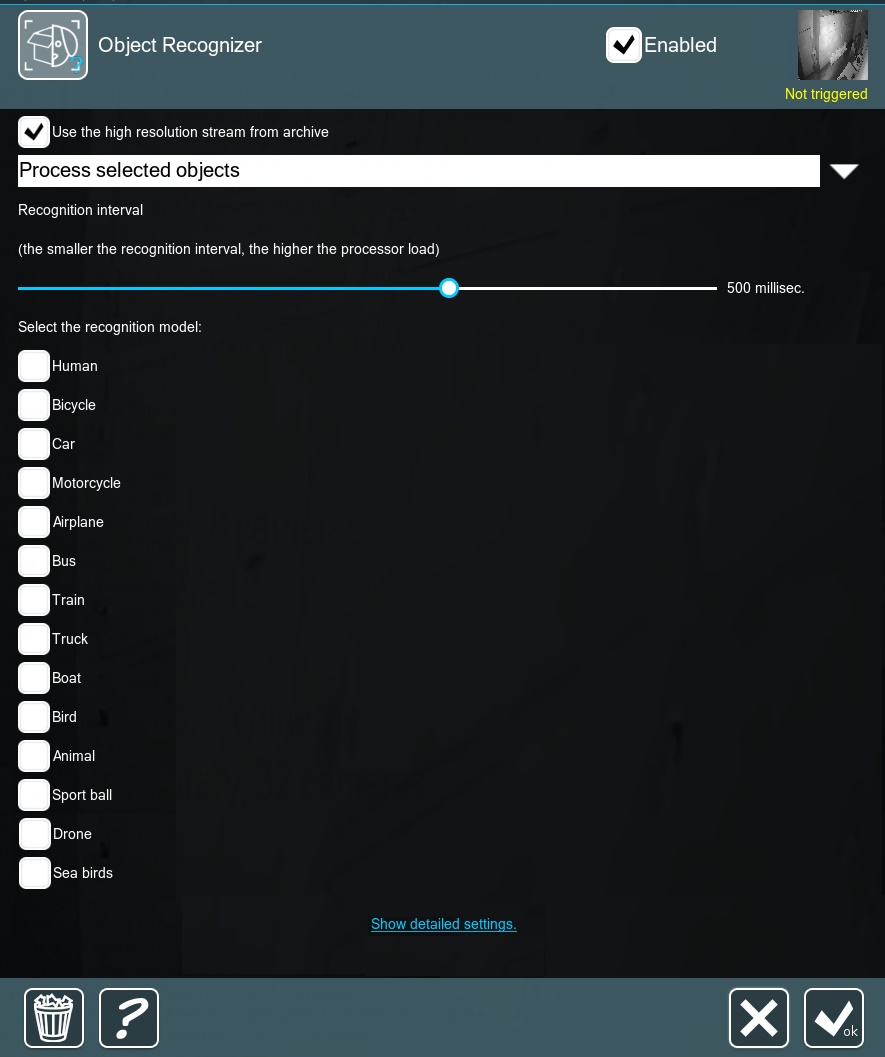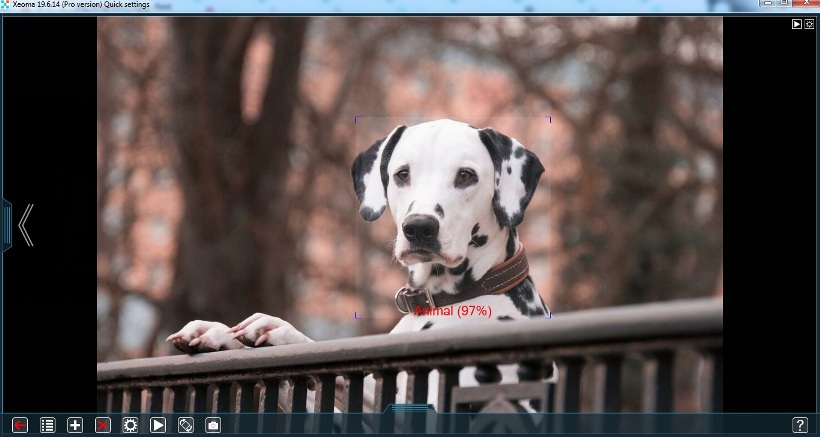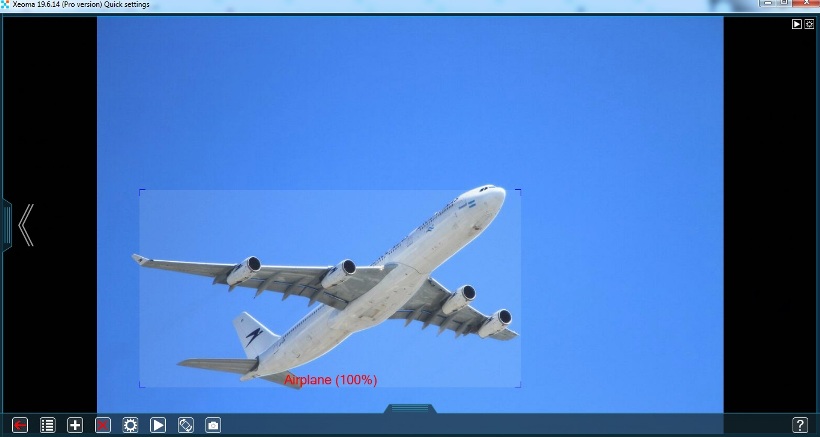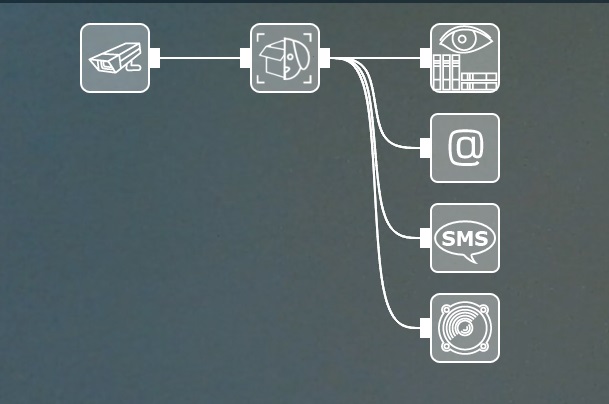|
|
Object recognizer in Xeoma: Setup details |
Intellectual module «Object recognizer» in Xeoma is capable of recognizing necessary object types in camera’s field of view:
• Airplane
• Animal
• Bicycle
• Bird
• Boat
• Bus
• Car
• Motorcycle
• Human
• Sport ball
• Train
• Truck
This module is based on artificial intelligence and deep machine learning that greatly improves its recognition accuracy.

There’s «Use the high resolution stream from archive» option available in the module’s settings, it means that module will be using higher resolution stream that is indicated in “Universal camera” module’s settings, and it can insignificantly increase CPU load.
«Object recognizer» can «Process selected objects» or «Not process selected objects», i.e. whenever module is triggered, it’ll pass (“skip”) the signal to the next modules in chain. If you need to detect one type of object and disregard another, then you can use 2 or more “Object recognizer” modules in the chain.
There’s also «Recognition interval» (time it takes to recognize particular object type) can be set in module’s settings. It can be used from 30 milliseconds and up to 3 seconds. The smaller the recognition interval, the higher the processor load will be.

|
Starting with Xeoma 22.3.16 the ‘Object Recognizer’ module is equipped with an alternative object recognition method – utilization of CUDA.
In some cases this option showcases higher object recognition accuracy. You will see this option only in Xeoma on machines that have a video graphics card with support for the CUDA technology (Nvidia GeForce 400 and up for Windows and GeForce GTX 750 and up for Linux). Note that the CUDA-powered recognition doesn’t affect the processor load – it will stay the same as with the regular object recognition on machines without CUDA. |
Each object type is accompanied by «Recognition accuracy» field that is responsible for percentage of recognition accuracy.

According to the selected percentage module will be looking for necessary objects in camera’s field of view. If you set up e.g. 90%, then Artificial intelligence will be looking for the objects that are 90% matching to the selected object type. So the lower the percentage, the lower the recognition accuracy, but recognition speed most probably will be faster.
You can choose multiple types of objects, but recognition accuracy will be higher if there are not so many objects in camera’s field of view.

Selected type (or multiple types) of object will be displayed on the screen as a frame with the name of the object and percentage of recognition.


|
Starting with Xeoma 22.3.16 the ‘Object Recognizer’ module can make reports in a spreadsheet format CSV.
The reports will have information on date and time of recognition, the type of object that was detected, and the accuracy percentage of how sure AI is that the object is what it thinks it is. |
You can use different modules after «Object recognizer» in the modules chain. They will receive the signal whenever «Object recognizer» is triggered.

You can use «Preview and archive» module, for example, then it’ll start recording whenever particular object is detected. Or you can use «Sending email»/«Sending SMS» modules, this way notifications will be sent after recognition. Also you can use «Sound alarm» module to turn on warning alarm whenever «Object recognizer» detected the object. Flexible modular system in Xeoma allows creating any desired system based on «Object recognizer».
Licensing
The ‘Object Recognizer’ module is an Additional module and should be purchased separately. The license for ‘Object Recognizer’ is activated on top of the basic Xeoma license, i.e. licenses for the Xeoma Standard and/or Xeoma Pro edition.
There are several types of licenses related to the ‘Object Recognizer’ module on the Purchase page:
![]() If drone and/or airplane detection will be used, a separate license ‘Drone and Airplane Recognition’ can be purchased. This license is purchased for the total number of modules on the server that will use ‘Object Recognizer’ to recognize UAVs or aircraft.
If drone and/or airplane detection will be used, a separate license ‘Drone and Airplane Recognition’ can be purchased. This license is purchased for the total number of modules on the server that will use ‘Object Recognizer’ to recognize UAVs or aircraft.
For example, 1 camera uses 1 module = 1 license; 1 camera uses 2 modules = 2 licenses; 2 cameras use 2 modules each = 4 licenses etc.
![]() If seabird recognition will be used, a separate ‘Seabird Recognition’ license can be purchased. This license is purchased for the total number of modules on the server that will use ‘Object Recognizer’ for seabird recognition.
If seabird recognition will be used, a separate ‘Seabird Recognition’ license can be purchased. This license is purchased for the total number of modules on the server that will use ‘Object Recognizer’ for seabird recognition.
For example, 1 camera uses 1 module = 1 license; 1 camera uses 2 modules = 2 licenses; 2 cameras use 2 modules each = 4 licenses etc.
![]() If you use the recognition of other types of objects from the ‘Object Recognizer’ module (trains, motorcycles, boats, birds or animals, sports balls, etc.), you can purchase an ‘Object Recognition’ license. This license is purchased for the total number of modules on the server that will use ‘Object Recognition’ for object recognition (except for drones, aircraft, seabirds).
If you use the recognition of other types of objects from the ‘Object Recognizer’ module (trains, motorcycles, boats, birds or animals, sports balls, etc.), you can purchase an ‘Object Recognition’ license. This license is purchased for the total number of modules on the server that will use ‘Object Recognition’ for object recognition (except for drones, aircraft, seabirds).
For example, 1 camera uses 1 module = 1 license; 1 camera uses 2 modules = 2 licenses; 2 cameras use 2 modules each = 4 licenses etc.
![]() Starting from the beta version of Xeoma 23.6.14, a new universal license “Recognition of 1 object” has been added, which lets you use any type of objects from the ‘Object Recognizer’ module. This license is purchased for the total number of modules on the server that will use ‘Object Recognizer’ for any types of objects offered by the module.
Starting from the beta version of Xeoma 23.6.14, a new universal license “Recognition of 1 object” has been added, which lets you use any type of objects from the ‘Object Recognizer’ module. This license is purchased for the total number of modules on the server that will use ‘Object Recognizer’ for any types of objects offered by the module.
For example, 1 camera uses 1 animal recognition = 1 license; 1 camera uses 1 animal recognition and 1 boat recognition = 2 licenses; 2 cameras use total 1 animal recognition, 1 boat recognition and 2 motorcycle recognitions = 4 licenses etc.
![]() Please note that Xeoma has other modules that react to various objects:
Please note that Xeoma has other modules that react to various objects:
Free testing
«Object recognizer» module can be tested in any version for 1 hour, after that period of time settings will be reset and 1 more hour will be available for testing.
Also watch our video about “Object Recognizer”:
June, 19 2019; updated February 24, 2022
Read also:
Additional modules in Xeoma
Object detector
